Why sitting is destroying your posture!
Contents
This is the first article I have written for this site and yes… I have chosen the most commonly talked about obvious topic. There are two main reasons why I chose to talk about sitting first.
- Firstly, sitting is without a doubt causing more postural problems for people than they realize.
- Secondly, when I looked around the net the vast majority of articles seemed to be over simplified, or trying to sell so called ‘ergonomic’ office furniture or back supports.
I aim for this article to be different. I will explain what sitting for long periods of time is actually doing to your body.
What’s wrong with sitting anyway?
Nothing…… for short periods of time anyway. But ask yourself how closely does the following match my daily life?
7am: Get out of bed and Sit down for breakfast.
8am: Sit in your car or on a train, bus or bike and go to work.
9am: Sit down at your desk or in your work vehicle and start your working day.
12pm: Take a break and Sit down for lunch.
1pm: Sit back down and get some work done.
5pm: Sit back in your car or on a train, bus or bike and head home.
6pm: Get home Sit down to eat and do some more Sitting in front of the TV or computer.
11pm: Go to bed and let your body contemplate what you have taught it over the course of the day.
See where I am going with this……………..
I’ve worked out that on average most people spend around 10 hours 37 minutes sitting per day (and that’s being generous with the math). So how far does that deviate from what are body evolved or were designed to do?
Primarily we were nomadic hunter gatherers and this is what our bodies evolved to do. We evolved to be efficient at moving; so that we could catch the deer, bend down and pick the berries, climb the tree and reach the honey or run away from the pack of wolves that wanted to eat us.
The closest our ancestors probably ever got to sitting in a chair was occasionally perching on a low fallen log or a rock by the fire at the end of the day. The chances are the rest of the time they squatted as it meant they were ready to move when they needed to and if nothing else it kept their bum dry.
Like every other species around on the planet today we are still here because our ancestors were good at staying alive, reproducing and passing their good genes on to us. Yes, our adaptability is one of the main reasons we are still around today and in my opinion we are still evolving.
However, due to technology and a shift from hunter gathering to farming our evolution has slowed down dramatically. 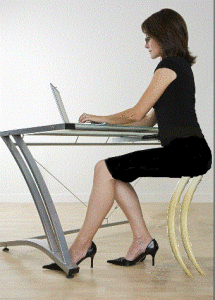 We are therefore very similar to our ancestors were 200 thousand years ago. We are still not designed to be sedentary creatures.
We are therefore very similar to our ancestors were 200 thousand years ago. We are still not designed to be sedentary creatures.
Unless there is some weird incredibly fast evolutionary jump that makes us grow a pair of ‘butt tusks’ I’m guessing that in 1000 years from now we will still not cope well with sitting with our hips at 90° all day.
Even if you don’t proscribe to the whole evolution thing and follow a faith based belief in how we came to be, do you believe that any god meant for us to sit on our bums for 10 hours a day?
What sitting does to your body
What happens to a chicken’s body when you stick it in a battery farm cage?
It’s actually very similar to what happens to a human when you stick it in a chair for 10+ hours per day. It puts on weight, it’s muscles weaken, it develops joint problems (such as osteoporosis), it develops poor blood circulation and is more reliant on antibiotics and other drugs to stay alive.
I’m going to leave the heart attacks, diabetes, weight gain, reduced sperm count, haemorrhoids and reduced cognitive function associated with prolonged sitting to others and just concentrate on posture. There is however a wealth of information out there if you’re interested.
People sit in many different positions; legs crossed, feet tucked under their chair, knees out, knees in, but most people tend to adopt a preferred position (articles on these coming soon). The problem is eventually if you accumulate enough time in this preferred position it becomes your default position even when you are stood up or performing other tasks.
Your body simply adapts to the task you are giving it, tissues lengthen, shorten and your wiring (nervous system) changes. Then you blow your back out while brushing your teeth and wonder….”How did that happen?”.
As I mentioned at the beginning of this article there is nothing wrong with sitting if it’s for short periods of time. It’s prolonged sitting or holding any other static position for long periods of time that’s the problem. Many studies have shown that sustained postures lasting more than 1 hour can deform bodily tissues. For example a study conducted on ’tissue creep’ by ‘McGill SM, Brown S, et all’ concluded that –
“Sitting with the back slouched for as little 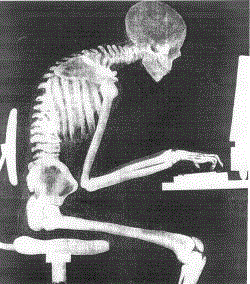 as 20 minutes can result in increased laxity of the posterior spinal ligaments. It may take 30 minutes or more for these ligaments to regain their previous level of stiffness.”
as 20 minutes can result in increased laxity of the posterior spinal ligaments. It may take 30 minutes or more for these ligaments to regain their previous level of stiffness.”
Simply put, if you spend long periods of time sitting in a static position you have to spend more time stood up or with your joints in the opposite position for the tissue to recover. Spend 30 minutes slumped in front of the TV it will take 40 minutes to undo it.
Here are a few of the typical problems associated with prolonged sitting.
Hip problems & lower back pain
The most important thing to realize when it comes to posture is that problems refer to other parts of the body. A problem in your ankle can actually effect your neck believe it or not.
When most of us sit with our hip at 90° our pelvis posteriorly rotated which means our lower back has to flatten or flex forward. Our hips also tend to stiffen up and in a lot of cases we end up with reduced hip extension.
Spend enough time like this and your risk of herniating a disk and throwing your back goes through the roof. It probably won’t happen while your sat down, more than likely you will bend down to pick your pen up and BAM you’re in serious pain!!
Again we wonder “How did that happen, it was just a pen?”. Mmm possibly because you have been stretching your lower back muscles and crushing the edges of your spinal disks all day. It may also have happened because your hips are so tight that your lower back has to make up for reduced movement when you move.
Upper back pain
We spend most of our time sat down reaching in front of ourselves to drive the car, use our computer or work at our desk. This causes us to round our shoulders and upper back. Our thoracic spine ends up bent over like a fishing rod stretching all the muscles that stabilize our vertebra.
The same thing happens from rounding and protracting our shoulders, the muscles that stabilize the bottom of our shoulder blades get stretched out and become unresponsive. The muscles at the top of our shoulder blades and our chest muscles get all messed up from hunching our shoulders.
Quick test for you…stand in front of a mirror in a relaxed position. Take a look at your hands, your thumbs should point straight ahead and not at each other. Did you pass the test?
Shoulder pain
We often don’t realize we have any shoulder problems until we try and do something over head and feel a pinching sensation or sharp pain it the front or side of our shoulder. Remember holding any static position for long periods of time causes tissues to change. Holding the steering wheel or using your computer in a bad position causes muscles and ligaments to stretch and deform and you end up with your arm bones to far forward in your shoulder sockets.
Head & Neck Pain
As mentioned before, what’s happening in one part of our body can refer to another. As everything else down the chain has flexed or moved forwards our head and neck have to adjust so that we are not sat starting at the floor. We tend to sit with our heads jutted out in front of us, staring into a monitor or through the windscreen of the car.
This bad position puts a lot of strain on the muscles running up the back of your neck and the cervical vertebra. Your neck muscles have to work really hard in this position to stabilize your head in order to keep the blood flowing to your brain, your airway open and your spinal cord safe. Over time we develop tight painful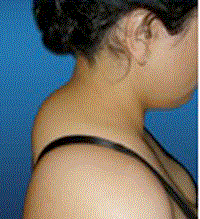 muscular knots forming around the base of our necks.
muscular knots forming around the base of our necks.
People usually don’t associate how stiff their neck feels in the morning with what they spent the previous day doing and just put it down to “Oh I must have slept in a funny position!”.
Often people get tension headaches from sitting in this position for long periods of time. If you’re really lucky you might develop a nice dowagers hump.
Knee pain
Just like the shoulder we don’t realize our knees are blown until we stand up and try and do something else. If your hips, knees and ankles have been in the same flexed position for hours on end it’s no wonder so many of us experience knee pain or are unable to run without destroying ourselves. Our knees end up making up for the reduced flexibility in our ankles and hips.
Panic attacks
Ok remember when I said I was going to stick to posture and leave the other problems associated with prolonged sitting to others……… I lied! I’ve know too many people with anxiety attacks not to mention this.
Sitting changes the way you breath. Yep you heard me right, by sitting all hunched up for hours you are literally changing the way you inhale. You’re also changing the oxygen content of your blood and messing with the mechanism that transports deoxygenated blood back to your heart.
The primary muscle involved in our breathing is the diaphragm. When your sat down in a slumped position the space inside your abdominal cavity is reduced. This makes it very difficult for the diaphragm to move properly. As most of us have tight hyperactive muscles around our chest and neck (due to poor sitting) our body starts to use the muscles of the neck and chest wall to lift the ribs and pull air in to the lungs.
The problem is that these breaths are very quick and shallow. The amount of oxygen we breathe in is increased which decreases the concentration of carbon dioxide in our blood. Our bodies respond to this lack of carbon dioxide by constricting our blood vessels. Ironically this actually reduces the amount of oxygen that can get to our brain. If the oxygen level in your brain gets too low adrenalin is pumped out which puts you in to a ‘fight or flight’ response i.e. a ‘panic attack’.
Breathing in this way becomes a habit, remember your body adapts to the task you are giving it. Maybe you won’t get panic attacks but breathing like this won’t help your stress levels. You can read more about it here.
Still not convinced?
In cultures where people squat (instead  of sitting at a series of 90 angles) there is less hip and lower back disease (amongst many other problems). Notice that their feet are flat on the floor and that they are comfortable enough in this position to actually play a game.
of sitting at a series of 90 angles) there is less hip and lower back disease (amongst many other problems). Notice that their feet are flat on the floor and that they are comfortable enough in this position to actually play a game.
The eagle-eyed amongst you may have noticed that some of the people in the picture have rounded lower backs. ‘So what’s the difference between their rounded lower back and mine when I am sat in my chair?’ I hear you ask. In short, their back and bum muscles are actually loaded and working to maintain the integrity of their spines in this squatting position. When your sat in a chair these muscles are off, so you end up hanging off your spinal ligaments and stretching the inactive muscles.
Think about it … why shouldn’t they be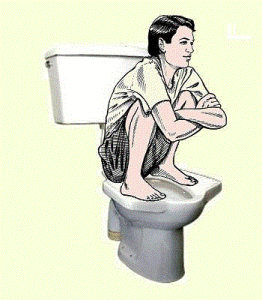 comfortable in this position? We are designed to go to the bathroom like this. Most of us can’t even get in this position anymore without lifting our heels off the floor and balancing precariously. What use would that be, we would back into what we just discarded. Why can’t we squat anymore? Could it be that it’s because we spend most of our lives locked in 90° angles?
comfortable in this position? We are designed to go to the bathroom like this. Most of us can’t even get in this position anymore without lifting our heels off the floor and balancing precariously. What use would that be, we would back into what we just discarded. Why can’t we squat anymore? Could it be that it’s because we spend most of our lives locked in 90° angles?
Ladies and gentlemen we’ve lost the ability to poop properly!
But I have to sit?
Yes most of us do have to sit as a part of our busy everyday lives. There are alternatives to static sitting though and in coming posts I will show you some of the alternatives and compromises you can make to help reduce the wear and tear on your body. In the meantime though just concentrate on changing your position as often as you can.
Phew after all this typing I need a rest…. think I will go and have a sit down!
If you think this article could be useful to someone you know, please help spread the word and share it.
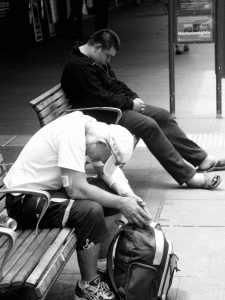
Simply Brilliant . thank god I found this
Great article! I will read more of them. I practice piano sat on a plyo-box. Also use a smaller one to squat and practice. Can lunge with knee on a yoga block to reach the keys as well. All this with LOTS of dynamic stretch breaks and hanging from my pull-up bar!
For chronic neck isesus from sitting at computer, make sure you keep your eye over your shoulder over your hips. In other words, no forward head posture. Make sure your computer screen is eye level, even if you must raise your screen. Good luck!